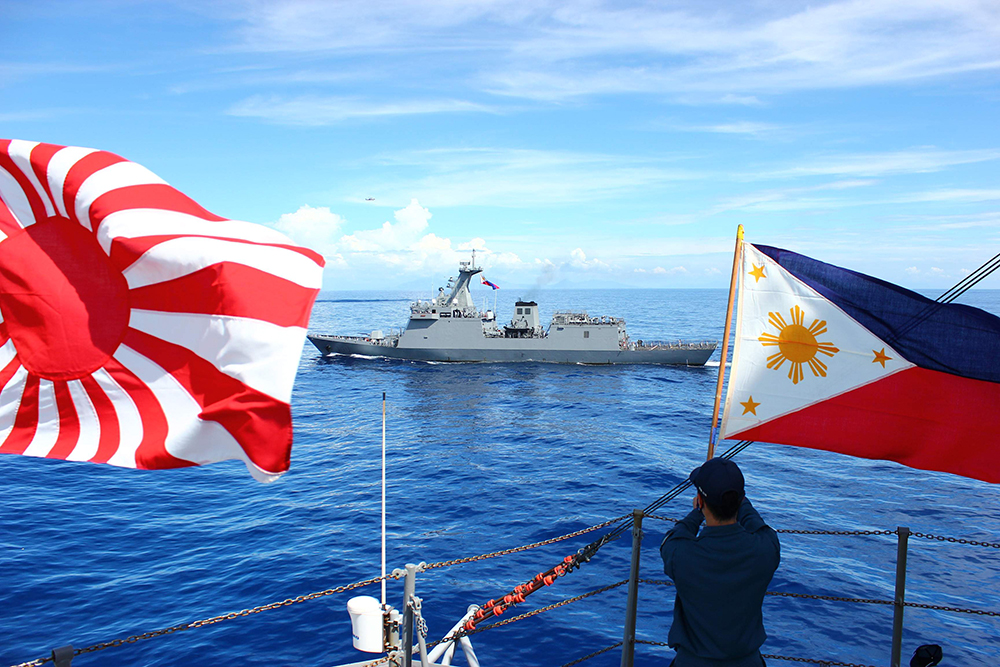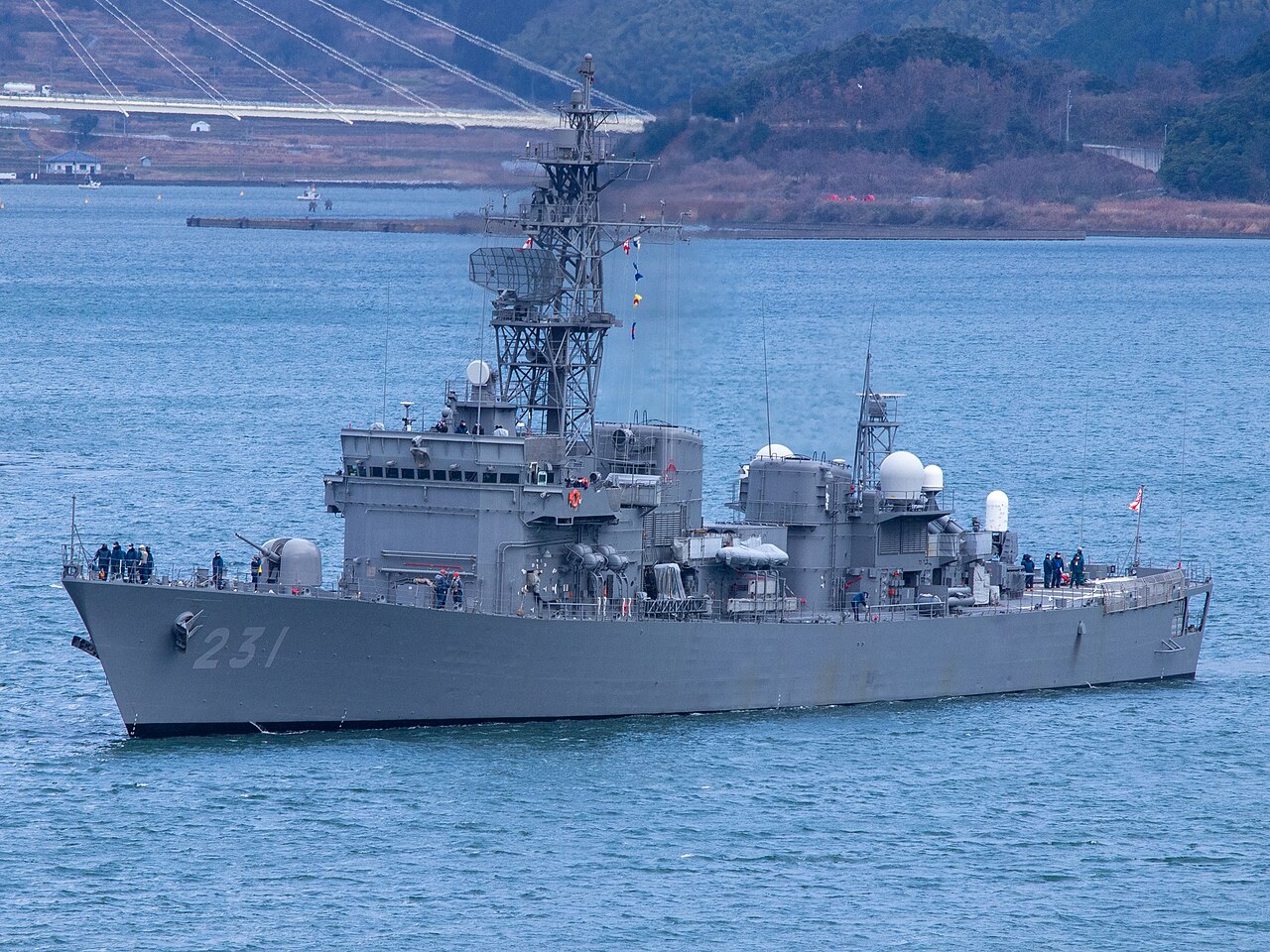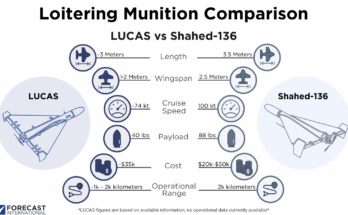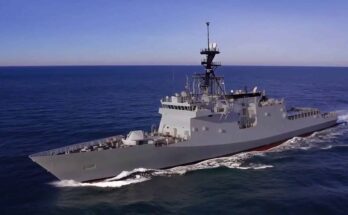
Japanese media revealed on July 6 that Japan plans to transfer its Abukuma-class destroyer escorts to the Philippines, potentially marking the first such export in modern Japanese history. Media reports were confirmed by statements from Philippine Navy officials that they had received invitations to inspect the ships and engage in “exploratory talks” regarding transfer. If completed, any number of Japan’s six 30-year-old warships could be headed to the Philippines, helping bolster the country’s maritime defense while offering Tokyo a foothold to showcase its naval platforms. The deal, if realized, offers practical advantages to both sides, as the two neighbors look to deepen their expanding cooperation in the defense sector.
Shoring Up The Shoals
The destroyer escorts (more similar to frigates in size and capability), brought into service between 1989 and 1993, are aged by Japanese standards, but could prove valuable to the Philippines, which suffers from a severe lack of major surface vessels. Particularly compared to neighboring China, which operates over 100 principal surface combatants, the Philippines is at a significant disadvantage, boasting only two recently procured Jose Rizal-class frigates, a single Miguel Malvar frigate, and a mix of small patrol vessels. The lack of comparative naval bulk is a significant security weakness for Manila, which sees routine friction and clashes with Chinese government and civilian boats over disputed shoals in the South China Sea.
Japan, like the Philippines, has concerns about China’s growing maritime assertiveness and encroaching claims in disputed regional waters. Tokyo’s supply of secondhand ships to Manila will allow it to indirectly counter China’s naval buildup while improving defense ties with a like-minded neighbor. As Japan modernizes and expands its fleet, such handoffs of older equipment could become a viable route to building regional partnerships that stymie Chinese interests at sea.
While the six Abukuma-class destroyer escorts wouldn’t fundamentally change the power calculus in the South China Sea, they would contribute to an improved security posture for the Philippine Navy and enable greater operational activity than Manila is currently capable of. Though not equipped with as many modern systems, the Abukuma class is comparable in size, speed and range to the Jose Rizal class. Age aside, these ships would be an asset for the Philippine Navy, allowing it to conduct longer-range patrols and sovereignty enforcement missions without risking or overtaxing its premier frigates. These ships are also fitted for anti-submarine warfare (ASW), a critical warfighting dimension in the shallow waters of the South China Sea, where China’s expanding submarine fleet conducts regular patrols.
A Growing Partnership
The willingness to transfer these ships, likely refurbished with newer Japanese systems, is a bold commitment to the blossoming defense relationship between the two countries, showing a growing confidence in the Philippines’ trustworthiness as a partner. Tokyo has already pushed for greater defense ties with Manila, including through the export of a dozen coast guard vessels, five TC-90 maritime patrol aircraft, air surveillance radars and several speedboats. The two nations even signed a Reciprocal Access Agreement last July, facilitating easier deployment of troops to each other’s territory in the event of emergencies or training events.

The larger Abukuma-class ships are a step above previous deliveries, and if transferred, may improve interoperability between the two navies while helping Philippine Navy personnel develop familiarity with Japanese vessels. If successfully done, this could open the door to future imports of more advanced Japanese naval platforms and systems. This move could be calculated to alter the trajectory of the Philippines’ arms procurement, which has drifted towards South Korea in recent years. South Korea’s Hyundai Heavy Industries (HHI) was tapped for Manila’s Jose Rizal-class and Miguel Malvar frigates and the incoming Rajah Sulayman class of offshore patrol vessels (OPVs). The delivery of larger ships from Japan could cultivate stronger ties and improve the likelihood of a future ship contract as the Philippines expands and modernizes its navy.
Export Practice
The export of a major warship is also somewhat novel for Japan, which, due to significant legal constraints on arms sales, has lacked experience in selling its vessels abroad. In recent years, Japan has eased regulations on its arms exports, opening wider caveats for jointly produced weapons and lethal systems. The country has designs on becoming a larger arms export player, particularly through shipbuilding, where it already has a competitive edge over many other nations.
Following several disappointing near-selections for some high-profile tenders, including Australia’s Pre-AUKUS Attack-class submarine, Japan has ratcheted up its marketing efforts to secure a major sale internationally. Mitsubishi Heavy Industries (MHI) has made it to the final selection for the Australian General Purpose Frigate Program, bidding with its advanced Mogami-class design, however, concerns about a lack of export experience have been a drag on its bid. Transferring the Abukuma class to the Philippines may help build inroads for future sales elsewhere, ideally lending credibility to Japan’s ability to sell and even build warships abroad.
While unlikely to catch as much attention as other major arms sales, Japan’s planned Abukuma class transfer to the Philippines is a calculated move that will ripple beyond the two nations. It signals Tokyo’s willingness to step more assertively into the regional security architecture through tangible material support, while testing the waters of naval export viability. For the Philippines, it promises meaningful operational enhancement at a critical time of tension with neighbors like China. The provision of these ships may contribute to future Japanese equipment selections from Manila and other regional partners, furthering Japan’s aims to take on a more active role in the defense industrial world of the Indo-Pacific.
Tom Freebairn is a weapons analyst with Military Periscope covering naval affairs and maritime systems. He pursued an undergraduate degree in International Relations and Modern History, followed by a master's in Middle East, Caucasus, and Central Asia Security Studies from the University of St. Andrews. His master's thesis focused on the relationship between oil and separatist politics in Northern Iraq. Tom's interests include the politics of energy, ethnic separatism, the evolution of naval warfare, and classical history.




